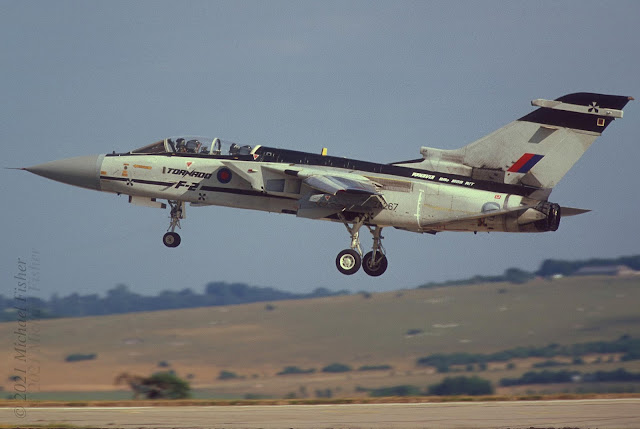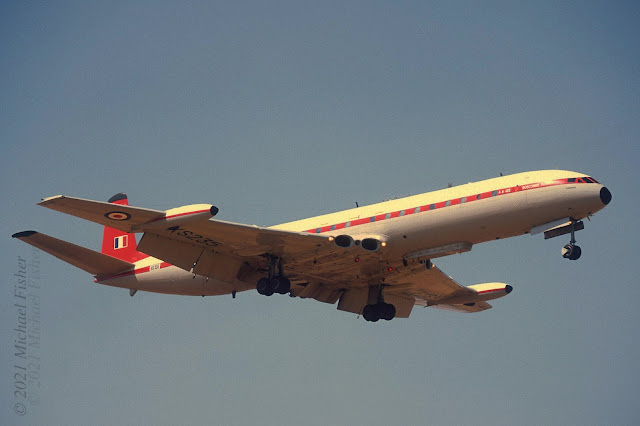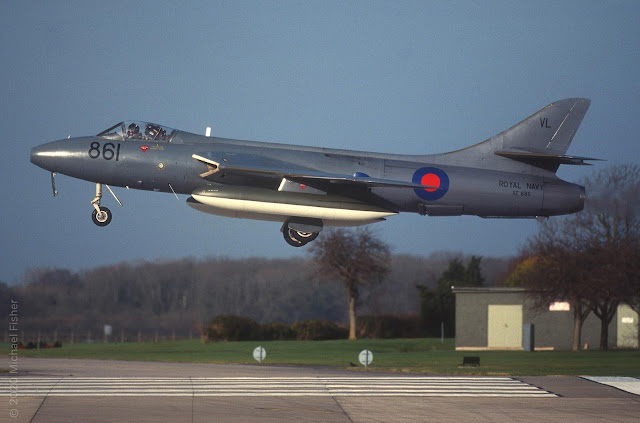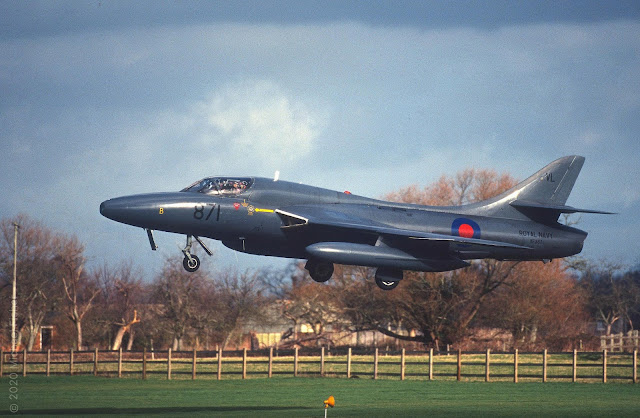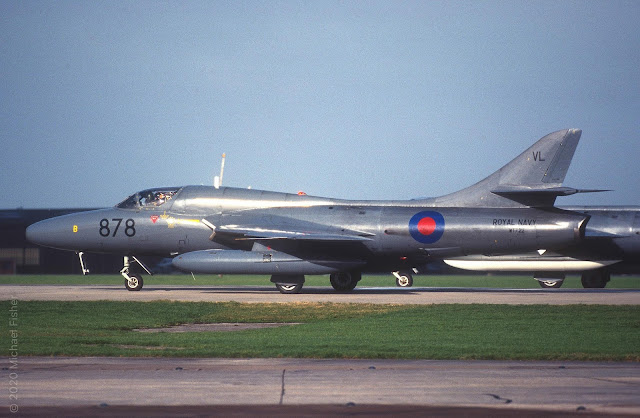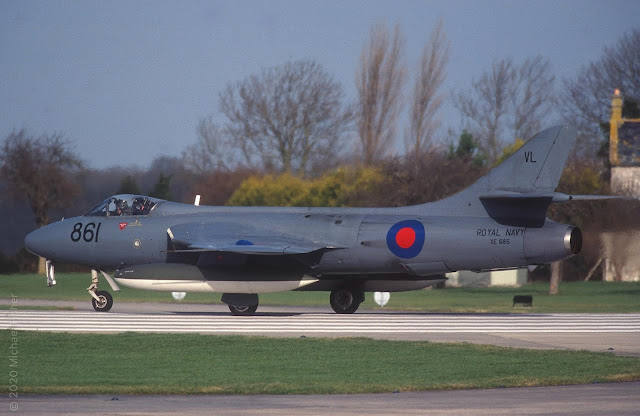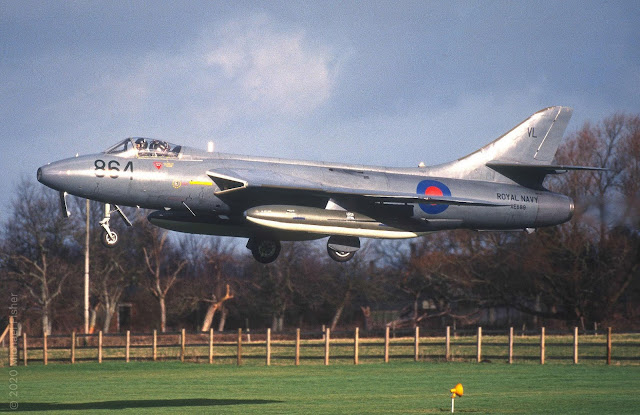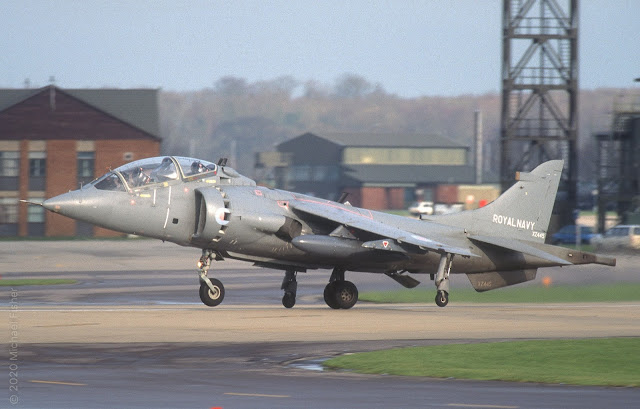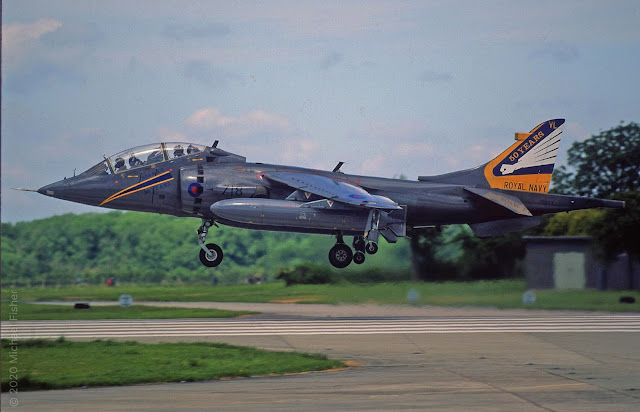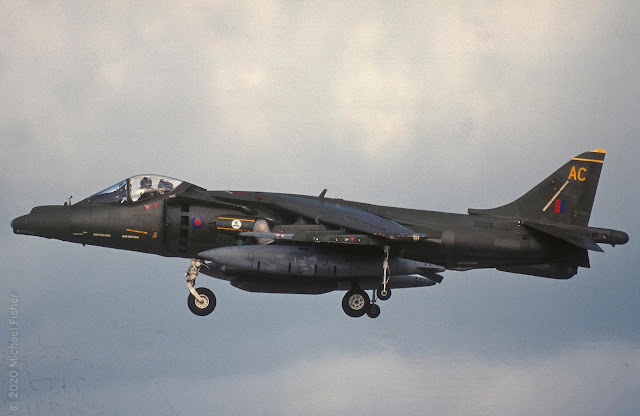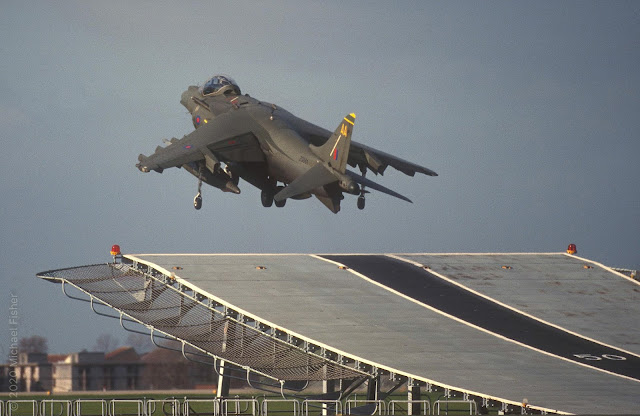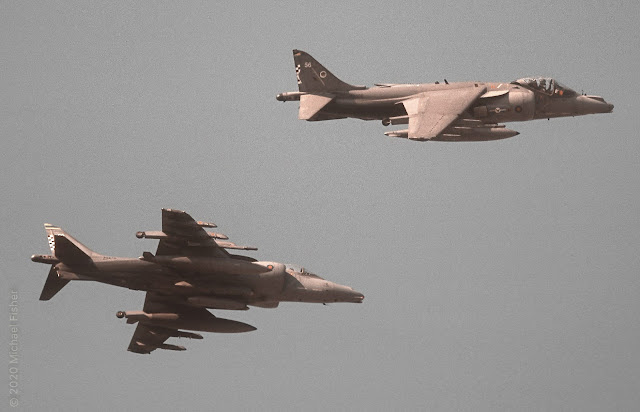XE685/861 'VL' Hunter GA.11 RN landing on runway 27 at RNAS Yeovilton. Transferred to the civil register as G-GAII at Exeter.
Sadly, moving to the civilian register as
G-BWGM.
XF357/871 'VL' Hunter T.8C Royal Navy (FRADU).
WV256/862 'VL' Hunter GA.11. Status: it became G-BZBP. It can be seen at RAF St Mawgan, where it bears the marks of 26 Squadron RAF, having previously served at RAF Oldenburg in Germany. Similar to the Harrier's story of not being saleable abroad due to American technology in their canopies, this Hunter was built at Kingston-Upon-Thames in 1955. It was presented for auction in 1995, forty years after entering service. Amazingly, did it have to be withdrawn from the auction due to American funding for its manufacture?
I would be very interested if anybody could shed further light on the financial implications.
WT722/878 'VL' Hunter T.8C. Its status was at the Classic Air Force hanger at RAF St Mawgan, but sadly, its civil registration has been cancelled, and its destiny has yet to be discovered.
XE685/861 'VL' Hunter GA.11 Royal Navy. These jets had a history. XE685 was built in Blackpool for the Royal Air Force in 1955. It entered service at RAF Lynham in Wiltshire and later transitioned to RAF Jever in Germany. Following RAF service, it was put into storage.
Acquired by the Royal Navy, it was converted to a GA.11 at Kingston-upon-Thames. It joined the Navy service at Lossiemouth, passing to RNAS Brawdy and then back to 'Lossie', before moving to Dunsfold and finally arriving at Yeovilton. It was scrapped on March 30, 1994, at the mere age of 39.
XE689/864 'VL' Hunter GA.11 suffered a fire in France and returned to Hyères airbase in Southern France. Following the incident, the rear fuselage was replaced with that of XE707, allowing it to return to service. It passed through the Lovaux works at Bournemouth Hurn airport in June 1994 for a major maintenance program and returned to Yeovilton in December 1994.
Sadly, the early retirement program saw Hunter XE689/864 "VL" withdrawn from service the following May 1995. On the 16th of that month, it was flown to RAF Shawbury for storage and, later in July'95, sold to the civilian register.
XZ492/128 Sea Harrier FRS.1 800Sqn late 1993 before passing to RAF St. Athan for conversion to an FRS.2.
It was great to see different models of the Sea Harrier operating at Yeovilton, as well as various shades of grey at the time.
XZ493/126 Sea Harrier FRS.1 800 Sqn, landing at Yeovilton in 1994. Later that year, it crashed into the Adriatic Sea while approaching
HMS Invincible.
It had also served with 801 NAS, providing combat air patrol missions (CAP) and protecting the ships of the British task force during the
Falklands conflict. Painted in a dark grey scheme, Argentinian pilots referred to it as '
La Mureta Negra' (The Black Death).
ZD615/723 Sea Harrier F/A2 899 Sqn OCU, recovering to (EGDY).
ZB604/722 Sea Harrier T.4N Royal Navy Lining up for a dummy deck launch.
The Navy's Training Harriers, the T.4N, had no radar, but pilot training on the radar instrumentation featured in the Harrier FRS1 aircraft was necessary. This led to FRADU utilising three
Blue Fox-equipped Hunter T8Ms as radar trainers.
XZ445 Sea Harrier T.4A(N), seen here in earlier years, sadly crashed near
Wellington, Somerset, in 1996 whilst flying through dense fog with the loss of its pilot and passenger.
RNAS Yeovilton was chosen as the airbase to host aircraft from 12 nations to celebrate this great event.
From January 1994, the NAS OCU relocated from RAF Boscombe Down back to RNAS Yeovilton, with their Sea Harrier FAS.2 then in service.
The T.4Ns were upgraded to T.8s, the first of which was delivered in early 1995, wearing the black colour scheme that would be seen on all the T.8s. They still had no radar, but the instrumentation was improved to a similar specification as the FAS.2 (FA.2).
Above ZD328/AC Harrier GR.7 from 3 Squadron RAF prepares to land before launching from the deck.
Following the commencement of the Joint Force Harrier (JFH) on April 1 2000, it was only a short time before Royal Air Force Harriers were seen using RNAS Yeovilton's dummy deck for training.
ZG861/AA Harrier GR.7 3 Squadron RAF with 848 Squadron Seaking HC.4 'Junglie' in the background.
ZG861/AA Harrier GR.7 RAF. Lining up in front of the deck.
ZG861/AA Harrier GR.7 airborne off the deck.
ZD410/AJ Harrier GR.7 RAF.
On my visits, the RAF always seemed to arrive with three aircraft.
ZD466/56 and ZD470/60 arriving overhead (EGDY).
"
St Bart's" is the spiritual home of the Fleet Air Arm.
On Sunny days like the one above, the Southside ramp was more reminiscent of
RAF Akrotiri in Cyprus.
ZD470/60 GR.7 RAF preparing for another deck launch.
ZD466/56 Harrier GR.7 with the Joint Harrier Force markings.
ZD466/56 Harrier GR.7 RAF.
ZD470/60 GR.7 RAF follows ZD466/56 airborne.
ZD610/000 Sea Harrier FA.2 'Shar' 899Sqn RN.
ZD610/000 Sea Harrier FA.2 'Shar' 899Sqn RN. Prepares to land for another deck launch.
ZD798/122 FA.2 Sea Harrier 801Sqn RN.
ZD605/VL-710 FA.2 Sea Harrier 899 Sqn Royal Navy.
ZH801/R-716 FA.2 Sea Harrier RN.
ZE692/718 FA.2 Sea Harrier and ZH809 FA.2 899Sqn, the 'Flying Fist'. The insignia derived from a flying gauntlet.
ZD990/721 T8 Sea Harrier 899Sqn RN practising vertical thrust lifts on a cold winter morning.
ZB605/720 T8 899 Sqn Sea Harrier departing Yeovilton.
ZD993/VL-723 T8 Sea Harrier 899 sqn Royal Navy.
ZD612/718 FA.2 899Sqn Run and break.
ZE696/126 FA.2 800Sqn RN.
ZH803/124 F/A2 800Sqn.
This aircraft has been re-registered as G-RNFA, owned by Fly Harrier Ltd.
It arrived at RAF St Athen from RNAS Culdrose, where it had been used at the School of Flight Deck Operations (RN SFDO). Maybe one day we will see it fly again?
ZH808/N-003 F/A2 Sea Harrier.
This is just a friendly reminder of those days when a Seaking HC.4 'Junglie' departs and a Lynx HAS.8 can be seen on the ground.
ZH813/006 FA.2 Sea Harrier 801 Sqn RN.
ZH796/VL-715 FA.2 899 Sqn RN.
ZH809 FA.2 Sea Harrier 899 Sqn.
Affectionately known as"Admiral's Barge."
ZH809 FA.2 Sea Harrier 899 Sqn. The 25th Anniversary scheme was applied for the 2004 display season to celebrate 25 years of Sea Harrier service in the Royal Navy.
As a late-production aircraft, it flew for only 8 years, accumulating 1,073 flying hours.
Just a lovely picture.
Farewell, my friends.
If you have reached this far, you may have enjoyed memories of some great days out in Somerset.
Happy Days!
